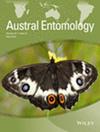First detection and eradication of a structural infestation by western drywood termite, Incisitermes minor (Hagen) (Isoptera: Kalotermitidae), in Australia
IF 1.1
3区 农林科学
Q3 ENTOMOLOGY
引用次数: 2
Abstract
The western drywood termite, Incisitermes minor, is one of the most economically damaging termites in the United States of America. Although native to the southwestern USA and northwestern Mexico, it has spread widely across the USA and to other countries including China and Japan. The first structural infestation by I. minor in Australia was detected in the timber roofing of a house in Sydney, NSW, in July 2019. Imported exotic timbers, including Douglas fir from the USA, installed approximately 20 years prior to the detection, were the likely source of the infestation. Measures undertaken to eradicate I. minor were (1) ‘tent’ fumigation of the house with sulphuryl fluoride; (2) trap deployment for termite alates; and (3) delimiting surveillance in nearby homes. No I. minor termites were detected outside the infested premises. The haplotype observed by way of DNA sequencing was similar to those of I. minor specimens collected from Louisiana, USA, and Japan. Given the potential economic impacts of I. minor, should it establish in Australia, along with other drywood termites, especially West Indian drywood termite, Cryptotermes brevis, government biosecurity organisations should devote more resources to the design and implementation of drywood termite management systems for new and existing buildings.澳大利亚首次发现并根除西部干木白蚁(等翅目:白蚁科)的结构性侵害
西部干木白蚁,小白蚁,是美国最具经济破坏性的白蚁之一。虽然原产于美国西南部和墨西哥西北部,但它已广泛传播到美国和其他国家,包括中国和日本。2019年7月,在新南威尔士州悉尼的一所房子的木材屋顶上发现了澳大利亚第一例I. minor的结构性侵扰。进口的外来木材,包括来自美国的道格拉斯冷杉,在发现前大约20年安装,可能是虫害的来源。为消灭小蝇虫而采取的措施是:(1)用硫酰氟对房屋进行“帐篷式”熏蒸;(2)设置白蚁陷阱;(3)划定附近住宅的监视范围。第一,在受感染的处所外发现了小白蚁。单倍型与美国路易斯安那州、日本等地采集的小蠓相似。考虑到I. minor的潜在经济影响,如果它与其他干木白蚁(尤其是西印度干木白蚁,Cryptotermes brevis)一起在澳大利亚建立起来,政府生物安全组织应该投入更多的资源来设计和实施新建筑和现有建筑的干木白蚁管理系统。
本文章由计算机程序翻译,如有差异,请以英文原文为准。
求助全文
约1分钟内获得全文
求助全文
来源期刊

Austral Entomology
ENTOMOLOGY-
CiteScore
3.20
自引率
0.00%
发文量
40
期刊介绍:
Austral Entomology is a scientific journal of entomology for the Southern Hemisphere. It publishes Original Articles that are peer-reviewed research papers from the study of the behaviour, biology, biosystematics, conservation biology, ecology, evolution, forensic and medical entomology, molecular biology, public health, urban entomology, physiology and the use and control of insects, arachnids and myriapods. The journal also publishes Reviews on research and theory or commentaries on current areas of research, innovation or rapid development likely to be of broad interest – these may be submitted or invited. Book Reviews will also be considered provided the works are of global significance. Manuscripts from authors in the Northern Hemisphere are encouraged provided that the research has relevance to or broad readership within the Southern Hemisphere. All submissions are peer-reviewed by at least two referees expert in the field of the submitted paper. Special issues are encouraged; please contact the Chief Editor for further information.
 求助内容:
求助内容: 应助结果提醒方式:
应助结果提醒方式:


